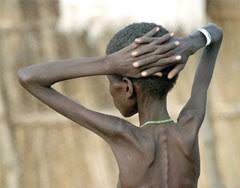- UNICEF Deputy Executive Director, Kitty van der Heijden, addressed a press briefing in Geneva, Switzerland, on Friday.
Malnutrition is a condition caused by an imbalance in nutrient intake, either due to a lack or excess of essential nutrients. It can lead to serious health problems, especially in children, such as stunted growth, a weakened immune system, and a higher risk of disease.
There are different forms of malnutrition:
Undernutrition: Includes wasting (low weight for height), stunting (low height for age), and deficiencies in vital vitamins and minerals.
Overnutrition: Linked to obesity and diet-related illnesses such as diabetes and heart disease.
Malnutrition remains a significant global health challenge, particularly in low-income areas with limited access to nutritious food and healthcare. Combating it requires efforts in food security, medical care, and education on proper nutrition.
Kitty Van der cautioned that decreasing financial support from international donors is endangering crucial nutrition programs.
In recent years, UNICEF, like other UN agencies, has experienced a drop in funding from key donors.
The situation deteriorated further at the start of U.S. President Donald Trump’s administration when a 90-day suspension was placed on all U.S. foreign aid. Historically, the U.S. has been UNICEF’s largest contributor.
Although the past 25 years have seen significant progress, with 55 million fewer stunted children, Heijden stated that insufficient funding is now undoing these achievements.
“Earlier this week, I witnessed the impact of the funding crisis firsthand during my visit to Ethiopia’s Afar region and Maiduguri in northeast Nigeria,” she said.
“Due to funding shortages in both countries, nearly 1.3 million children under five suffering from severe acute malnutrition could lose access to treatment this year, putting them at greater risk of death.
In Afar, a region frequently affected by droughts and floods, I visited a mobile health and nutrition team delivering life-saving care to pastoralist communities in remote areas without health clinics. These teams play a crucial role in supporting children by providing essential treatment for severe wasting, vaccinations, and vital medicines.”
“We estimate that without additional funding, UNICEF will deplete its supply of Ready-to-Use Therapeutic Food (RUTF) for treating children with severe wasting by May. This could have severe consequences for approximately 74,500 children in Ethiopia who need treatment each month.
In Nigeria, where around 80,000 children require treatment monthly, RUTF supplies could run out between this month and the end of May.”
The UNICEF official urged governments and donors to increase funding for the organization’s nutrition programs, warning that failing to do so could have devastating effects on millions of children worldwide.
“In 2025, an estimated 213 million children across 146 countries will need humanitarian aid. We cannot afford to let them down,” she emphasized.
“Every dollar spent on nutrition programs can yield up to $16 in economic benefits. We call on governments and donors to prioritize investments in children’s nutrition and overall well-being.”
Addressing malnutrition requires a multi-faceted approach that tackles both undernutrition and overnutrition. Key solutions include:
1. Enhancing Food Security
Ensure access to affordable, nutritious food, particularly for vulnerable groups.
Promote sustainable farming methods to boost food production and variety.
Strengthen food distribution systems to minimize waste and ensure fair access.
2. Supporting Maternal and Child Nutrition
Encourage breastfeeding to provide essential nutrients and strengthen immunity.
Offer nutrient-rich complementary foods for young children.
Educate mothers on proper nutrition during pregnancy and early childhood.
3. Providing Micronutrient Supplements and Fortified Foods
Fortify staple foods with essential vitamins and minerals (e.g., iodized salt, iron-enriched grains).
Distribute vital supplements like vitamin A, iron, and folic acid to at-risk groups.
4. Strengthening Healthcare Services
Improve healthcare access for early malnutrition detection and treatment.
Expand programs offering Ready-to-Use Therapeutic Foods (RUTF) for severely malnourished children.
Train healthcare workers to prevent and manage malnutrition cases.
5. Promoting Nutrition Education and Awareness
Implement school and community programs that encourage healthy eating habits.
Educate communities on balanced diets and proper hygiene practices.
Advocate for behavior changes to combat unhealthy dietary patterns linked to obesity.
6. Reducing Poverty and Social Inequality
Establish social protection initiatives, such as food aid and cash transfer programs, to support low-income families.
Create job opportunities and improve livelihoods to make nutritious food more affordable.
Invest in education, particularly for women and girls, to enhance household nutrition.
7. Strengthening Policies and Global Support
Develop and enforce policies that promote nutrition-focused programs.
Increase funding for nutrition interventions.
Foster global partnerships to combat malnutrition worldwide.
Combining these strategies is crucial to preventing and reducing malnutrition, ensuring better health and well-being for individuals and communities.










